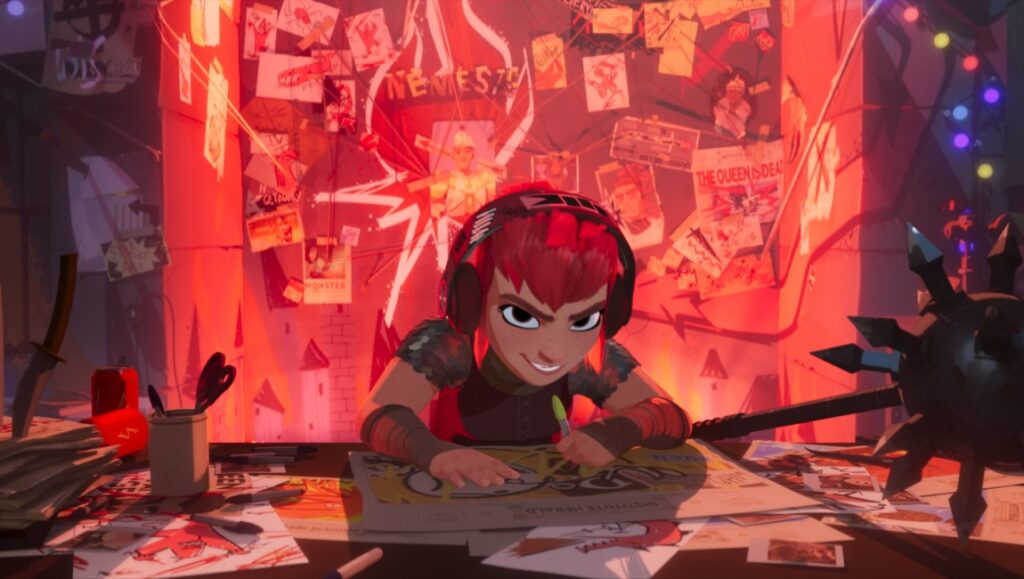Nimona, the animated film adaption of ND Stevenson’s graphic novel of the same name — itself an expanded print edition of the cartoonist’s popular Tumblr-based webcomic/senior thesis that ran from 2012 to 2014 — boasts the kind of plagued production that usually results in a project’s cancellation. Which is exactly what happened in February 2021, after Disney shuttered Blue Sky Studios. But a year later, Megan Ellison’s Annapurna Pictures announced it had resurrected the film (which had five fully-animated sequences already completed at the time of its cancellation), moved production to DNEG (far more prolific in the sphere of VFX), and partnered with Netflix for the film’s release. None of which sounds all that promising in a present-day industry where competing streaming services gobble up otherwise shelved projects in their never-ending hunger for content, but it’s surprisingly hard to argue that the vibrant version of Nimona that just hit Netflix isn’t preferable to what Blue Sky — which basically stayed afloat on the bones of the Ice Age franchise while farting out also-rans like Rio, Epic, and Ferdinand in between installments — would have delivered.
Also surprising is how competent Netflix’s animation division has been when taking stock of its limited release catalog, with impressive projects courtesy of Richard Linklater, Guillermo del Toro, Henry Selick, and Cartoon Saloon landing in 2022 alone. It’s easy to see a film stickered with the streaming giant’s name and take an immediately cynical stance, but perhaps given that track record in the world of animation, it shouldn’t be surprising that Nimona is as visually appealing and technically accomplished as it is. Occupying a strange liminal space that merges current-day signifiers (subways, digital displays), high-tech sci-fi trappings (futuristic weaponry), and fantasy classicism built upon medieval settings and design, the film follows a disgraced knight, Ballister Boldheart (whose surname was changed from the graphic novel’s Blackheart for… presumably a reason?), who is on the run after killing the queen. Except he was framed. Ambrosius Goldenloin, champion knight of the “Institute” sent to bring Ballister to justice, doesn’t know this. And neither does Nimona, a mysterious shapeshifter with their own ax to grind, who tracks Ballister down and forwards herself as the perfect sidekick in his war against the Institute. Things are quickly cleared up, but the two still don’t understand each other; Nimona doesn’t understand Ballister’s fealty to an establishment that would betray him, and he doesn’t understand… Nimona.
It’s here that we enter into a stretch of the film that offers up both the best and worst of what Nimona has to offer. On the one hand, there’s an appealing anarchy that the character of Nimona brings, all barely harnessed chaos, precociousness dialed up to eleven and punctuated with a dose of giddily irreverent humor. For a while, we’re firmly circling antihero territory, with Ballister’s codes of honor getting suplexed by Nimona’s struggles with impulse control and seeming moral ambivalence. But then things take an inelegant right turn into the territory of representation and inclusivity, and stay there for a while. Unlike Stevenson’s — who is trans — source material, which was able to develop this subject matter with care and nuance, the film — which runs only 101 minutes to begin with, a full 18 of which are dedicated to the end credits — doesn’t leave the space to do anything of the sort, choosing instead to pummel viewers with its central metaphor, temporarily stagnating the film’s momentum and executing its conceit with all the softness of a sledgehammer. “I’m just trying to understand what I’m working with here,” Ballister states at one point, in response to Nimona’s assertions of “I’m not a girl!” After another Nimona transformation, Ballister observes, “Now you’re a boy?” to which Nimona replies, “Today I am.” There’s certainly value in exploring the clumsiness of the well-intentioned, but the problem with this dump of discourse is that in this age of social media-encouraged solipsism, genuine feeling and empathy for others has been displaced by buzzword-driven rhetoric and an algorithm-approved application. The murky relationship between Ballister and Ambrosius is handled more elegantly here, but it’s a small grace in a film that reflects a brain-dulled, kneejerk inclination toward the unthinking absolutism of cancel culture. Built into Nimona’s handling of its discourse is the suggestion that audiences can’t muster the attention span or compassion to engage with such ideas without their being blatant and shallow — and sadly, that’s collectively more true than we’d like to admit in this age of self-righteous sanctimony.
Admittedly, that saturation of poor execution reflects only a small (though still fairly governing) portion of Nimona, and there are greater pleasures to be found in the mash-up of 2D and 3D renderings, playful approach to traditional genre signifiers, and incorporation of geometric textures into its candy-colored world. But Nimona ultimately suffers most from arriving at an unfortunate moment in film animation. Earlier in June, Across the Spider-Verse re-imagined the very notion of what animated films, specifically those based on existing visual art, could be, obliterating the lines between mediums and forms, realizing a kind of living comic book on screen. And last week, Lonely Castle in the Mirror, likewise based on a massively popular work of fantasy located at the intersection of adult and young adult literature, more gracefully demonstrated what art seeking to reflect and engender a culture of compassion looks like. It’s never fair to judge a film for what it’s not, and Nimona has plenty of visual pizzazz and personality to capture youngsters’ attention — which is also where its discursive concerns will resonate most — but it’s hard not be feel frustrated by a film of such clear conviction that falls into the same trap of shallow signposting that has infected mass culture.
You can currently stream Nimona on Netflix.
Published as part of InRO Weekly — Volume 1, Issue 26
Enjoy our content? Want early access to features, interviews, and more? Support us on Patreon!


Comments are closed.